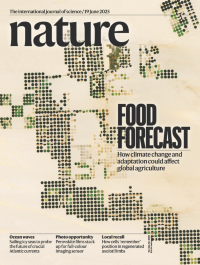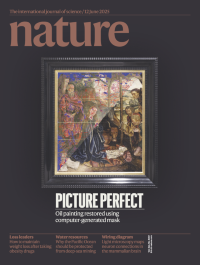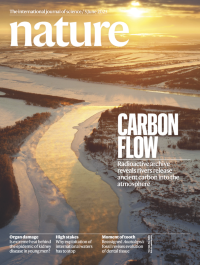Volume 642
-
No. 8069 26 June 2025
‘Cyborg’ tadpolesThe ability to track neural activity as the brain develops in embryos is key to understanding how neurons self-assemble to form the vertebrate brain. In this week’s issue, Jia Liu and colleagues present a bioelectronic solution to this problem in the shape of a soft, stretchable, mesh microelectrode array that can be implanted at the embryonic stage to map the electrical activity of neurons as the embryo grows. Working with frog and axolotl embryos, the researchers implanted their mesh array in the 2D structure called the neural plate, which goes on to become the brain. The array integrates with the plate, stretching and deforming as the brain develops, and providing feedback on how single-neuron activity and population dynamics emerge and evolve. The process is captured on the cover in an artist’s impression of the mesh array in place during the four main stages of frog embryo development.
Nature Index
-
No. 8068 19 June 2025
Food forecastThe cover shows a satellite image of circular patches of irrigated land in the Western Desert in Egypt. Such land reclamation is one of many strategies that could be deployed to mitigate the effects of climate change on agriculture and land use. But understanding how adaptation in the face of a warming climate might affect food systems is uncertain — models have so far tended to focus on a single region and so have generated conflicting results. In this week’s issue, Andrew Hultgren and colleagues present a model the brings together data for six staple crops across the globe. The researchers focused on maize, soya beans, rice, wheat, cassava and sorghum, drawing data from 12,658 regions across 55 countries to estimate the impacts of producer adaptation during the coming century. They estimate that for every 1 °C increase in temperature, food production will decline from current levels by 120 calories per person per day, but that income growth and adaptation strategies could alleviate 23% of global losses by 2050 and 34% by 2100.
-
No. 8067 12 June 2025
Picture perfectMuseums and galleries around the world hold a huge number of paintings; many of which are damaged and locked away in storage. Restoring artwork is a painstaking, expensive process — made that much more difficult by the fact often there are thousands of intricate blemishes present. Digital scans and reconstructions have been used to guide restoration work, but there is no easy way to transfer the digitally repaired image to the actual artwork. In this week’s issue, Alex Kachkine presents an approach that turns a computer-generated reconstruction into a reversible physical restoration, cutting the time and costs involved in repairing damaged paintings. The artwork is first digitized and the damaged areas are identified. Generative models are then used to predict how the restored painting should look, and the necessary changes are printed onto a laminate mask. The fully removable mask is then applied to the painting, restoring it to its former glory. Kachkine demonstrates this technique by restoring the fifteenth-century oil painting, attributed to Master of the Prado Adoration, shown on the cover — which is split between the scan of the damage and the final restoration.
-
No. 8066 5 June 2025
Carbon flowRivers and streams are a significant source of carbon, releasing both carbon dioxide and methane from their surface waters into the atmosphere. The vast majority of this carbon was thought to come from recent biomass production — organic material that had been broken down and carried into the river system in the past 70 years or so. But in this week’s issue, Joshua Dean and colleagues reveal that some 60% of the carbon released by rivers is much older, dating back hundreds to thousands of years ago or more. The researchers combined new and published measurements of radioactive carbon-14 in rivers to create a database covering nearly 700 river reaches around the world. By comparing the levels of carbon-14 in the river samples with a standard reference for modern atmospheric CO2, the team was able to date the river carbon. The discovery suggests that there is a slow, persistent release of ancient carbon from rivers and raises questions about how that might alter as land use changes.




